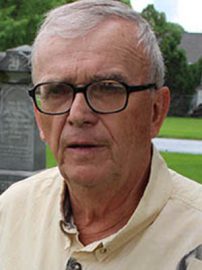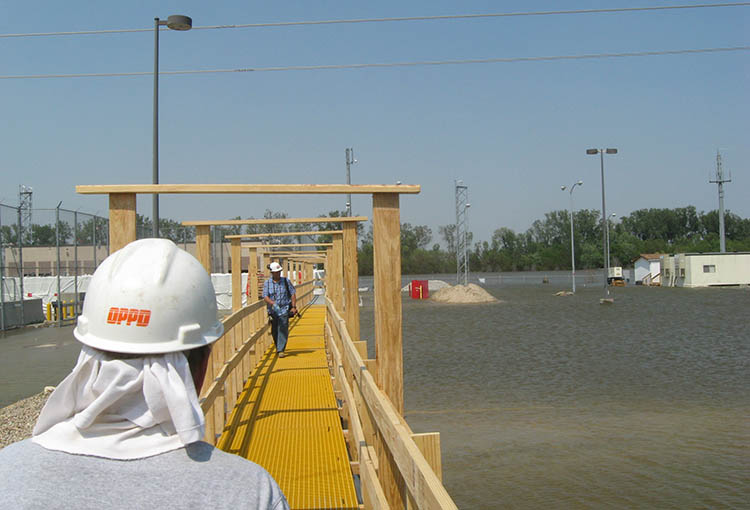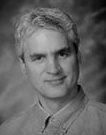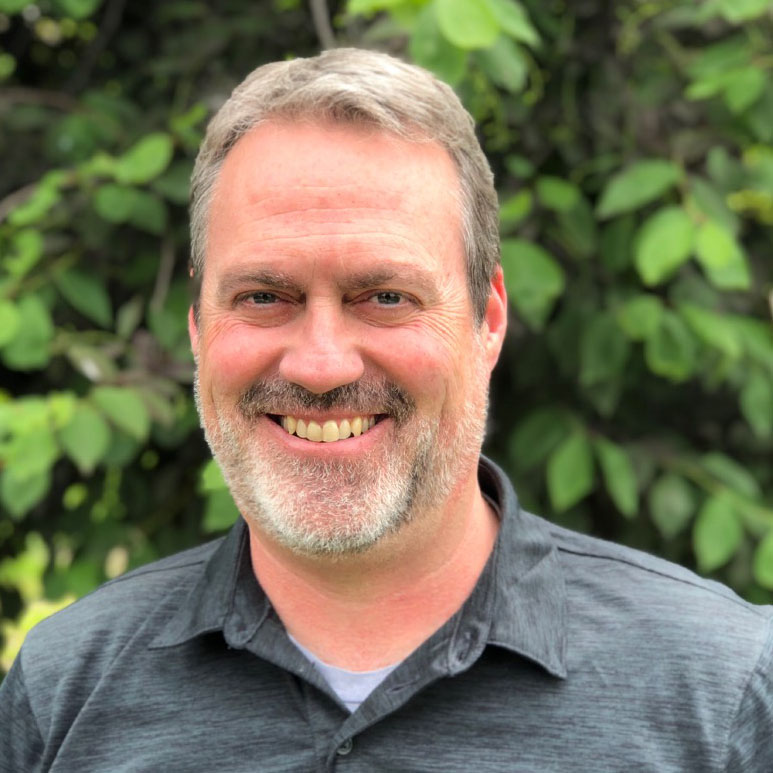Employees tell the story of Fort Calhoun Station

POWERFUL LIFE
Fort Calhoun Station will cease operations by the end of 2016. The plant has played a crucial role in OPPD’s history for four decades. Since it began producing electricity in September 1973, FCS has accounted for nearly one-third of the district’s generation, adding a carbon-free fuel to the mix.
For many employees and retirees, the plant will always hold a special place as it helped fuel the growth of our communities and provided for their families.
Here are some of their memories of working at FCS.
BILL JONES
39 years, 1960-1999, retired as senior vice president
In 1967, I drove a station wagon from New York City to Washington D.C. I was delivering documents and required reports for our license to construct the plant to the Atomic Energy Commission.
I felt a lot of pressure delivering those documents, it wasn’t like I was familiar with Washington D.C. or anything. That station wagon was filled with boxes of documents. I remember the address, 1717 H Street. From there I had to go to their technical offices in Bethesda, Md.

We filed on March 18, 1967, and got our construction permit after a lot of review from the Atomic Energy Commission.
I was one of the first employees of Fort Calhoun Station. The first employees on site were Leon Kloke and John Hopp, who were in the Quality Assurance group providing construction oversight. In October 1968, six of us were in a training program and we got licensed at a different nuclear plant, a small plant in Altoona, Pa. We worked there long enough to get our reactor operator equivalency license.
The original plant staff had many individuals who had previous nuclear experience in the U.S. Navy.
CARL RENNERFELDT
33 years, 1970 – 2003, retired as operations training specialist
 During construction time, there were so many contractors all over the station doing all that work. We would be out there just walking around trying to figure out how the systems would work. Employees could walk to the intake structure, the intake tunnel; we got to see parts of the plant that will never be seen again. It was the same with the containment building and the auxiliary building. We got to go places people will never go to again. The construction was just amazing to see. This was in 1971. One day you’d be able to walk into an area that was open and the next day, it was covered by concrete.
During construction time, there were so many contractors all over the station doing all that work. We would be out there just walking around trying to figure out how the systems would work. Employees could walk to the intake structure, the intake tunnel; we got to see parts of the plant that will never be seen again. It was the same with the containment building and the auxiliary building. We got to go places people will never go to again. The construction was just amazing to see. This was in 1971. One day you’d be able to walk into an area that was open and the next day, it was covered by concrete.
FRED FRANCO
41 years, 1951 – 1993, retired as manager of radiological services

We went critical in August of 1973, and we were watching it closely as we approached criticality (the point where the reactor begins normal operation). For the several days leading up to that, I took my family camping in the hills northwest of the plant, at old Christ Child Camp. Every few hours I’d go back down to the plant and check levels. It was just convenient for me, and I wanted to be close to this historic event. I got to do my job and be close to my family.
It was a big challenge but a great, great time. We just went step by step, very carefully. We celebrated at the plant and then I went back up to our camp and had a nice cookout.
It was probably the highlight of my life, aside from my family. I remember a lot of experiments in college that didn’t work. This one did.

BILL JONES: When we first started making electricity, in August 1973, that was a big deal. It was exciting and kind of heart-stopping when the reactor went critical and the turbine first started turning.
I was in the control room, there were about 15 of us. We were trying to maintain a real safe and serious atmosphere, but you could tell something important happened.
CLARENCE BRUNNERT
33 years, 1971 – 2004, retired as nuclear review specialist

I remember the first few refueling outages. We were still learning how to do things. With each one, we got more and more efficient, especially the routine work. Back then, our staff was much smaller. You knew everyone’s first names and a little bit about their families.
There was one winter we had to battle frazil ice (slush-like mixture of ice crystals) that was getting on the intake structure screens. Everyone was out there scooping it away, a real team effort. We never lost river water and were able to manually keep it clear. Eventually a diversion device was put in up-river.
ROGER FRAKES
31 years, 1971 – 2002, retired as senior production planner
 I went there in late ’73 as a temporary transfer and the first row of parking was clear down by the river at the time. I was badge number 93, and I was told I’d come in just under the radar as they didn’t think they’d have to ever issue a badge there in the triple digits.
I went there in late ’73 as a temporary transfer and the first row of parking was clear down by the river at the time. I was badge number 93, and I was told I’d come in just under the radar as they didn’t think they’d have to ever issue a badge there in the triple digits.
The highlight for me was working with John Simodynes, chief engineer, on some of the outages. He’d call up and I’d ask him if he had any special projects going. When he said yes, I knew I had to sign up. You couldn’t have drug me out of there with all the rope in town. It was like watching an accomplished pianist. That was really a milestone for me in my career there, working with him on projects. It was as close to magical as I’ve ever seen.

CARL RENNERFELDT: Up until about 1976, we would have Thanksgiving dinners out at the plant. You’d get in for your shift and put the turkey in. At the end, our wives and kids would all be in the control room that we had set up for the dinner. It was a real family affair back then. That had carried over from Jones Street and North Omaha. The second shift would come in and they’d do the same thing.
CHARLIE VANECEK
34 years, 1961 – 1996, shift supervisor
 The plant ran so well for a lot of years. We knew who held the record for the longest run, and we had our fingers crossed that a big storm wouldn’t come along and trip us off. When it happened (September 1988, FCS set the record run for continuous operation by running continuously for 477 days, 13 hours and 15 minutes), I think there was a party that night. It really took all the groups and all the shifts working together to make it happen.
The plant ran so well for a lot of years. We knew who held the record for the longest run, and we had our fingers crossed that a big storm wouldn’t come along and trip us off. When it happened (September 1988, FCS set the record run for continuous operation by running continuously for 477 days, 13 hours and 15 minutes), I think there was a party that night. It really took all the groups and all the shifts working together to make it happen.
CARL RENNERFELDT: Before the training center opened, we had “Trailer City” where there were eight to 10 trailers we worked out of. It got so cold in the winter when you’d have to go to meetings or go out and get a ream of paper. Moving into the training center was just wonderful, incredible even. Everyone was there together, we had classrooms and work spaces. It was a fun time. Before that, our control room in the trailer was just photographs mounted on plywood to simulate control panels.
DEAN PODOLL
25 years, 1978 – 2004, retired as senior instructional technologist
 I started there in 1989, as part of the additional staff hired after FCS was put on the NRC’s watch list. I enjoyed every day I worked there. We had good supervisors and managers, and our facilities kept getting better and better. In the 1990s, INPO (Institute of Nuclear Power Operators) rated us as one of the top plants in the nation, and everyone was very proud to work there. I was fortunate to find a job I really enjoyed.
I started there in 1989, as part of the additional staff hired after FCS was put on the NRC’s watch list. I enjoyed every day I worked there. We had good supervisors and managers, and our facilities kept getting better and better. In the 1990s, INPO (Institute of Nuclear Power Operators) rated us as one of the top plants in the nation, and everyone was very proud to work there. I was fortunate to find a job I really enjoyed.
RICH JAWORSKI
35 years, 1969 – 2004, retired as supervisor nuclear licensing
 Technology-wise, we had to change how we did business. We had papers, telephones and secretaries, no voicemail, email or pagers. We had to develop along with those office skills. All these papers and documents that needed signing, trying to get 10 guys to sign off on something was quite a chore back then.
Technology-wise, we had to change how we did business. We had papers, telephones and secretaries, no voicemail, email or pagers. We had to develop along with those office skills. All these papers and documents that needed signing, trying to get 10 guys to sign off on something was quite a chore back then.
Fuel budgets were part of my job then. You’d have to use decks of computer cards and it would take a whole day. I remember the first computer. We had one PC approved for 15 engineers and it was wheeled all around. You had to put your name on a list to use it.
SUDESH GAMBHIR
29 years, 1979 – 2007, retired as division manager nuclear projects
In 2006, OPPD completed the most extensive and complex refurbishment outage in the history of the nuclear industry in 85 days, 2 hours and one minute. It was a huge success and Fort Calhoun won the Top Industry Performance Award in 2008 from the Nuclear Energy Institute. I’m very proud of the team involved in the project. This was a team effort that involved individuals from several OPPD divisions. For example, Finance provided fiscal and risk oversight, T&D worked on the switchyard, Material Management provided contract support, Corporate Communications kept everyone informed and Production Operations provided Central Maintenance support.

We had parts coming from several countries and craft personnel coming from 49 states. The steam generators, reactor vessel head and pressurizer came from Japan. The turbine rotor was assembled and tested in Switzerland with parts from Poland, Germany and France. The simulator came from Canada and the main transformer came from Austria. I think this was OPPD’s finest moment and a high point. Our motto was “One Team, One Goal.” It was our chance to either sink or swim with clear expectations that “success is the only option.”
CLARENCE BRUNNERT: I was amazed at all the work that got done (during the 2006 refurbishment outage) and that we got done ahead of schedule and under budget. I was one of the naysayers who said it couldn’t be done, but as I saw the work progressing, I said, ‘we can do this.’
CHARLIE SMITH
8 years, 2008-present, unit supervisor
I worked at a nuclear reactor in college (Worcester Polytechnic Institute in Massachusetts) and it was a great job and I knew I wanted to work for a nuclear plant. When I toured here during my interview, I just remember being so impressed by the sheer size of the circulating water pump motors. I’d never seen a motor so big. I had a couple offers out of college so I had to decide where I wanted to go. Everyone was so welcoming at Fort Calhoun and I talked to my parents about where I should go and they told me ‘you already have your mind made up, you just need someone to tell you it’s okay to go.’ I started in January 2008. It was a steep learning curve at that point, most of the other guys were out of the Navy and had experience.
I remember when I finished my qualifications my shift manager sat me down and had me write down all the safety systems I was responsible for: I filled up half a white board. He told me that’s what I’m responsible for out in the field and it was very empowering.
There were two other operators that I was hired with and a few months ago we were all standing there and one of the guys looked up and ‘this is pretty cool, the three of us with our licenses, here standing watch together.’ That was a very cool thing.
JEFF HANSON
17 years, 1998 – 2016, manager public information/community relations
 During the 2011 flood we received a lot of attention and focus and much of that was due to RT.com, the Russian government site. We took the local media and CNN on a tour of the site after the NRC chair left. I’d seen pictures from the site, but walking across the elevated walkway and seeing the flowing water below really struck me. People there put in long hours, people doing things that you train and prepare for, but then to actually execute it. These guys were doing a lot of engineering as it happened and keeping the area as safe as possible.
During the 2011 flood we received a lot of attention and focus and much of that was due to RT.com, the Russian government site. We took the local media and CNN on a tour of the site after the NRC chair left. I’d seen pictures from the site, but walking across the elevated walkway and seeing the flowing water below really struck me. People there put in long hours, people doing things that you train and prepare for, but then to actually execute it. These guys were doing a lot of engineering as it happened and keeping the area as safe as possible.

JOHN BRANDEAU
Project manager in Nuclear Project Management
 During the flood, I was the manager in charge of protecting assets. We put up the aquaberms and the Hesco barriers, and my memory was how hard everyone worked to put up the barriers for those two weeks.
During the flood, I was the manager in charge of protecting assets. We put up the aquaberms and the Hesco barriers, and my memory was how hard everyone worked to put up the barriers for those two weeks.
A lot of people came out and all the doers came to the front. That water was coming up six inches a day, every day. We didn’t know how high it would get. We put up three-quarters of a mile of elevated walkways, I know because I measured it out. Pumps were everywhere. We ended up using 350,000 sand bags.
 From our perspective, the flood showed the best of Fort Calhoun. I still have the original overhead photo we used to draw up our protection plan. It has squiggly marks and circles all over it where we drew up the elevations. We figured out how to protect the site in an afternoon. It was just playing pick-up ball, calling vendors on the fly. And it wasn’t just us, T&D rewired the plant, put up the storm restoration poles in three days; volunteers came from across the company to load sandbags, transportation provided equipment on short notice, and so on.
From our perspective, the flood showed the best of Fort Calhoun. I still have the original overhead photo we used to draw up our protection plan. It has squiggly marks and circles all over it where we drew up the elevations. We figured out how to protect the site in an afternoon. It was just playing pick-up ball, calling vendors on the fly. And it wasn’t just us, T&D rewired the plant, put up the storm restoration poles in three days; volunteers came from across the company to load sandbags, transportation provided equipment on short notice, and so on.
It was hot, interesting, challenging, sweaty work, and I never heard a single complaint. It was certainly uncharted territory, but it was a big success.

DEB MATTHEWS
31 years, 1983 – 2014, manager, nuclear projects
 The year of the flood, it was actually a wonderful summer for weather. It wasn’t like we had a continued deluge of rain, the sun was always shining and trees blooming, when they weren’t under water. We went to work in our river boots and stomped across the scaffolding. I worked with some amazing people, I wouldn’t do it over again, but I’m glad I did it.
The year of the flood, it was actually a wonderful summer for weather. It wasn’t like we had a continued deluge of rain, the sun was always shining and trees blooming, when they weren’t under water. We went to work in our river boots and stomped across the scaffolding. I worked with some amazing people, I wouldn’t do it over again, but I’m glad I did it.
MIKE RIVA
23 years, 1991 – 2014, superintendent maintenance
 I was working at the Saddle Creek site (old Omaha Center) running computer analysis when my job changed and I had to go back to FCS during the flood. When I got there, the whole outside of the building was under water. We had to park at Blair High School and take school buses to the top of the hill at the plant. Then you’d sit and wait for a Chrysler minivan to take you to the bottom of the hill and then walk on a scaffold from the Training Center to the security building, more than 100 yards with the river flowing underneath.
I was working at the Saddle Creek site (old Omaha Center) running computer analysis when my job changed and I had to go back to FCS during the flood. When I got there, the whole outside of the building was under water. We had to park at Blair High School and take school buses to the top of the hill at the plant. Then you’d sit and wait for a Chrysler minivan to take you to the bottom of the hill and then walk on a scaffold from the Training Center to the security building, more than 100 yards with the river flowing underneath.
I was in charge of maintenance planners and we prepared thousands of work orders to get the plant back online. The neat thing I remember were all the young, talented engineers that came in. They were really impressive and working with them was really inspiring. It was incredible all the work we did. It was really a great team.
CRAIG LONGUA
1993 – present, outage manager
It’s the people that resonate with me. The dedication of the people at the station. That has been evident since the day I was hired in June 1993. I’ve watched them struggle to get back online, the outages, maintaining the equipment and working as a team. To see the sacrifices the employees have made, and it all came to a head in 2011, watching the employees sandbag and run equipment in hot conditions. Everyone sweating and walking through four or five feet of water to do the work. And then after we lost the aquaberm, seeing everyone rallying and working to protect the plant. We did again after the breaker room fire in June 2011, everyone rallying to protect the plant, the dedication and effort of all the employees to get the equipment back up and running and make sure the fuel was all safe. Everyone watched out for everyone else. I never felt I wasn’t safe at the station because they were watching my back, and I was watching theirs.
JACOB WELCHERT
Supervisor, maintenance
 For two weeks we were working to protect the plant. We did the preliminary protection and then we had to try and sustain what we had protected. You have a group of people out here, and you know what they do, but then to see everyone come out from behind their desks, get their hands dirty and help do what needed to be done, that was very cool. And then to see everyone unite as a front, it’s something I hadn’t seen before, from the top to the bottom of the organization. It was pretty eye-opening to see just what this place meant to everybody.
For two weeks we were working to protect the plant. We did the preliminary protection and then we had to try and sustain what we had protected. You have a group of people out here, and you know what they do, but then to see everyone come out from behind their desks, get their hands dirty and help do what needed to be done, that was very cool. And then to see everyone unite as a front, it’s something I hadn’t seen before, from the top to the bottom of the organization. It was pretty eye-opening to see just what this place meant to everybody.
Every day you threw on your waders and would see what was needed for the day. I’d go over and fix a pump and then I’d be boating various supplies in and out of the plant. You’d walk into the plant and bring in a full five-gallon gas can and then take an empty one on your way out.

I remember we had crawfish that would gather at the base of the aquaberms where there was moisture. Raccoons figured this out and would get the crawfish and climb on top of the aquaberms to eat them. We had to chase raccoons off so they wouldn’t puncture the berms. Eventually we had to trap and release them away from the site. The flood response came down to everyone’s involvement, and that’s the only reason the place was successful.
Now I’m going to be working on replacing the roof membrane above the control room. I was up there during the extended outage putting up the tornado missile shield modifications (to protect against objects that could be propelled by a tornado). I’ll be back up on the roof, still getting chased around by pigeons.

Jason Kuiper joined OPPD as a communications specialist in 2015. He is a former staff writer and reporter at the Omaha World-Herald, where he covered a wide range of topics but spent the majority of his career covering crime. He is a graduate of the University of Nebraska at Omaha and has also appeared in several true crime documentary shows. In his free time he enjoys cooking, spending time with his wife and three children, and reading crime novels.
View all posts by Jason Kuiper >







